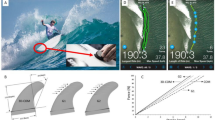Abstract
Free diving is a sport that in the past few years has increased in importance, in terms of the number and the level of practising athletes. To reach depths close to 100 m in constant ballast, new physical and mental training techniques have been developed, and innovative materials and new shapes have been adopted for the fins. Usually the introduction of such improvements is based on manufacturers’ experience, while their evaluation is remitted to athlete’s opinions and not to quantitative measures. The aim of this study is to assess a new simple methodology to determine quantitatively the performance of free-diving fins. This methodology is shown in detail and the results of an analysis on a very popular fin are reported.
Similar content being viewed by others
References
Atzori, B., Petrone, N. & Zanatta, D. (1997) Analisi biomeccanica e simulazione numerica del movimento di pinneggiata subacquea. Atti del XXXVI Convegno Nazionale AIAS, Catania, Italy (in Italian).
Christianson, R., Weltman, G. & Egstrom, G. (1965) Thrust forces in underwater swimming.Human Factors, December 1965, pp. 561–8.
Ecott, T. (2001)Neutral Buoyancy, Penguin Books, London.
Lyttle, A. & Blanksby, B. (2000) A look at gliding and underwater kicking in the swim turn. ISBS 2000 Applied Proceedings of the XVIII International Symposium on Biomechanics in Sports Swimming, Edited by Ross Sanders and Youlian Hong.
Minak, G. (2003) Experimental analysis of free diving fins. Proceedings of the 4th International Congress of the Croatian Society of Mechanics, Bizovac, Croatia.
Pendergast, D. R., Mollendorf, J., Logue, C. & Samimy, S. (2003a) Evaluation of fins used in underwater swimming.Undersea & Hyperbaric Medicine,30 (1), 57–73.
Pendergast, D. R., Mollendorf, J., Logue, C. & Samimy, S. (2003b) Underwater fin swimming in women with reference to fin selection.Undersea & Hyperbaric Medicine,1 (30) 75–85.
Pendergast, D. R., Zamparo, P., di Prampero, P. E., Capelli, C., Cerretelli, P., Termin, A., Craig Jr, A., Bushnell, D., Paschke, D. & Mollendorf, J. (2003 c)European Journal of Applied Physiology,90, 377–86.
Picken, J. & Crow, C. T. (1974) Performance efficiency of swim fins.Ocean Engineering,2, 251–8.
Rejman, M. (2001) The dynamic and timing criteria for assessing the single fin swimming technique.Acta Bioengineering and Biomechanics,3 (2), 67–79.
Zamparo, P., Pendergast, D. R., Termin, B. & Minetti, A.E. (2002) How fins affect the economy and efficiency of human swimming.Journal of Experimental Biology,205, 2665–76.
Author information
Authors and Affiliations
Corresponding author
Rights and permissions
About this article
Cite this article
Minak, G. Evaluation of the performances of free-diving fins. Sports Eng 7, 153–158 (2004). https://doi.org/10.1007/BF02844053
Issue Date:
DOI: https://doi.org/10.1007/BF02844053




